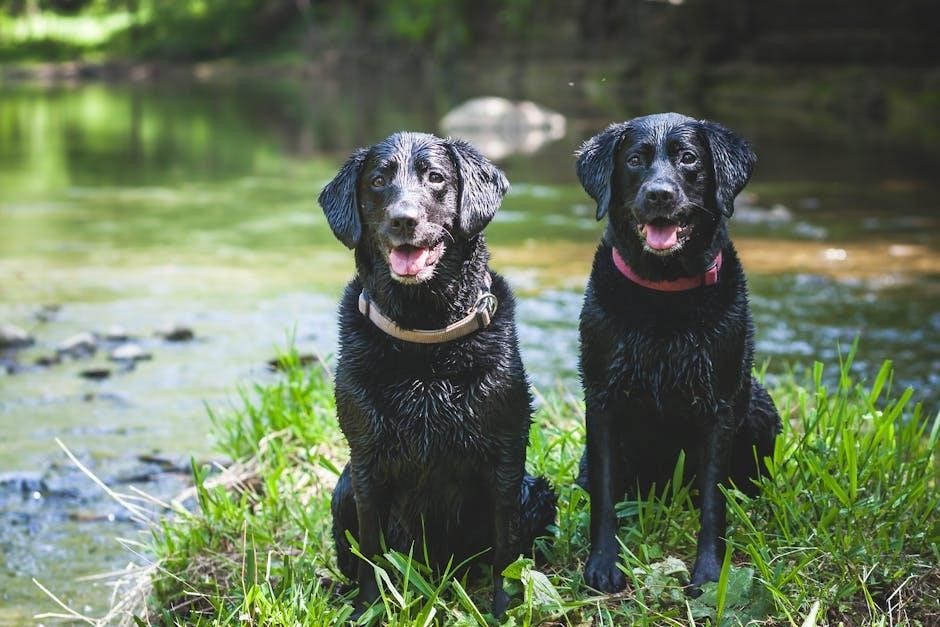
pre spay instructions for dogs
Pre-spay instructions are essential for ensuring your dog’s surgery and recovery go smoothly. These guidelines help prepare your dog for the procedure and promote a safe, effective outcome.
1.1 Understanding the Importance of Spaying Your Dog
Spaying your dog is a critical decision that offers numerous benefits for their health, behavior, and overall well-being. This surgical procedure prevents unwanted breeding and reduces the risk of certain health issues, such as uterine infections and breast tumors. Spaying also curbs undesirable behaviors like roaming or heat-related anxiety. By preventing unwanted litters, it helps control pet overpopulation, ensuring fewer dogs end up in shelters. Additionally, spaying can lead to a longer, healthier life for your dog, making it a responsible and compassionate choice for pet owners. Understanding these benefits helps you make an informed decision for your dog’s future.
1.2 Benefits of Spaying: Health, Behavioral, and Population Control
Spaying your dog offers significant health benefits, including reduced risks of uterine infections, breast tumors, and ovarian cancer. Behaviorally, it can minimize heat cycles, aggression, and unwanted breeding behaviors. Spaying also plays a crucial role in population control, preventing unwanted litters and reducing the number of homeless dogs. This procedure promotes a healthier, calmer pet and contributes to societal efforts to manage animal populations. By addressing these key areas—health, behavior, and population—spaying creates a positive impact on both your dog’s life and the broader community of animals. It is a proactive step toward ensuring your dog’s well-being and societal responsibility.
Pre-Surgery Preparation
Pre-surgery preparation involves scheduling the right time, ensuring your dog’s health, and completing vaccinations. Gather necessary supplies like an E-collar and pain medication to ensure readiness for the procedure.
2.1 Scheduling the Spay Surgery: Choosing the Right Time
Scheduling your dog’s spay surgery requires careful consideration to ensure optimal timing. Most veterinarians recommend spaying before the first heat cycle to reduce health risks and prevent unwanted breeding. Dogs over three months typically need up-to-date vaccinations, including rabies, at least two weeks prior to surgery. Avoid scheduling during extreme weather conditions or when your dog is under stress. Proper timing ensures your dog is healthy enough for the procedure and aids in a smoother recovery. Consulting with your veterinarian will help determine the best time based on your dog’s age, health, and lifestyle.
2.2 Veterinary Consultation: Ensuring Your Dog is Healthy Enough for Surgery
A pre-surgery veterinary consultation is crucial to ensure your dog is healthy enough for spay surgery. Your vet will perform a physical exam, review vaccination records, and may run blood tests to check for potential risks. Discuss your dog’s medical history, including any allergies or previous illnesses, to avoid complications. If your dog has an underlying condition, the vet may postpone surgery until it’s resolved. This step ensures your dog is cleared for anesthesia and surgery, minimizing risks and ensuring a safe procedure. Be prepared to ask questions and address any concerns during this consultation.
2.3 Vaccination Requirements: Ensuring Your Dog is Up-to-Date
Vaccination requirements are critical before spay surgery to ensure your dog’s safety. Dogs over 3 months must be current on core vaccines, including Rabies, distemper, and parvovirus. Some clinics may require a Rabies vaccine on the day of surgery if it’s not up-to-date. Vaccinations protect your dog from diseases and reduce surgical risks. Ensure your dog’s vaccination record is reviewed by the vet during the pre-surgery consultation. Vaccines should be administered at least two weeks before surgery to allow time for immunity to develop. Following these guidelines ensures your dog is safe for anesthesia and surgery, preventing postponement of the procedure.
Dietary Restrictions Before Spay Surgery
Fasting is required before spay surgery to ensure your dog’s safety under anesthesia. Stop feeding your dog after midnight, but water may still be allowed in small amounts.
3.1 Fasting Guidelines: When to Stop Feeding Your Dog
Your dog must stop eating solid foods after midnight the night before surgery. The last meal should be given by 8 PM, and no treats or milk afterward. This fasting ensures your dog’s stomach is empty, reducing anesthesia risks. Water is usually allowed in small amounts until morning, but check with your vet for specifics. Adhering to these guidelines is critical for a safe procedure and to prevent delays. Failure to fast may result in surgery postponement. Always confirm fasting rules with your veterinarian, as instructions may vary slightly depending on your dog’s age or health conditions.
3.2 No Food or Treats After Midnight: Preparing for Anesthesia
Your dog must not eat or receive treats after midnight the night before surgery. This ensures their stomach is empty, reducing anesthesia risks like vomiting or aspiration. The last meal should be given by 8 PM, and no food, milk, or snacks should be provided thereafter. While water is often allowed in small amounts until morning, confirm this with your vet. Adhering to this rule is crucial for a safe procedure. Failure to comply may delay surgery. Always follow your veterinarian’s specific fasting instructions, as they may vary based on your dog’s age, size, or health conditions.
3.3 Water Intake: What’s Allowed on the Day of Surgery
On the day of surgery, water intake guidelines vary. Typically, dogs are allowed limited water in the morning to prevent dehydration, but this must be stopped a few hours before arrival. Excessive water can complicate anesthesia, so your vet may advise withholding water entirely after a certain time. Always follow specific instructions provided by your veterinarian, as policies can differ. Ensuring your dog’s hydration levels are appropriate is crucial for a smooth procedure. If unsure, contact your vet for clarification to avoid any risks or delays in the surgery schedule.

Necessary Supplies for Pre- and Post-Surgery Care
- An E-collar to prevent licking or biting the incision site.
- Pain medication prescribed by the vet for post-surgery discomfort.
- A leash and carrier for safe transportation to and from the clinic.
4.1 E-Collar (Elizabethan Collar): Preventing Licking or Biting the Incision
An E-collar, or Elizabethan collar, is a crucial supply for post-surgery care. It prevents your dog from licking or biting the incision site, which can lead to infection or reopening the wound. The cone-shaped collar restricts access to the surgical area, ensuring proper healing. Your veterinarian will typically provide or recommend the appropriate size and type of E-collar for your dog. It’s essential to use the collar as directed to avoid complications. While some dogs may find it uncomfortable at first, it’s a necessary tool for a smooth recovery. Always follow your vet’s instructions regarding its use and removal.
4.2 Pain Medication: Ensuring Your Dog’s Comfort Post-Surgery
Pain medication is vital for your dog’s comfort after spay surgery. Your veterinarian will prescribe appropriate medication to manage discomfort and prevent pain. It’s crucial to administer the medication as directed to ensure your dog’s recovery is smooth and stress-free. Never use human painkillers, as they can be toxic to dogs. Follow the prescribed dosage and schedule to avoid overmedication. Proper pain management helps reduce anxiety, prevents complications, and allows your dog to rest and heal effectively. Always consult your vet if you notice signs of distress or if your dog isn’t responding well to the medication.
4.4 Leash and Carrier: Safe Transportation to and from the Clinic
A secure leash and carrier are essential for safely transporting your dog to and from the clinic. Dogs must be on a leash, and cats in individual carriers to prevent escape or injury. Carriers help keep your dog calm and secure during travel. Choose a sturdy, well-ventilated carrier that fits your dog comfortably. Ensure your dog is familiar with the carrier beforehand to reduce anxiety. On the day of surgery, arrive with your dog on a leash and in the carrier to maintain safety and control. This ensures a smooth and stress-free experience for both you and your pet.

The Day of Surgery
On the day of surgery, arrive on time, follow pre-operative guidelines, and ensure your dog’s safety. The clinic will handle the procedure with professional care.
5.1 Arrival Time and Preparation
Arrive at the scheduled time to ensure a smooth process. Bring your dog on a leash, and have all necessary items ready, such as vaccination records and payment. Sign consent forms upon arrival, reviewing the procedure details. Your dog will be checked in, weighed, and prepared for surgery. Ensure your dog has fasted since midnight and confirm all pre-operative instructions are followed. Vaccinations must be up-to-date, and avoid last-minute feeding or water intake. Be prepared for a brief discussion with the veterinary team regarding your dog’s health and any concerns. This preparation ensures your dog is ready for a safe and successful surgery.
5.2 Signing Consent Forms: Understanding the Surgical Procedure
Signing consent forms is a critical step before your dog’s spay surgery. These forms authorize the procedure and outline the risks, benefits, and potential complications. Review the document carefully to ensure you understand the surgical process. The form may also cover anesthesia use and post-operative care instructions. This is your opportunity to ask questions and clarify any concerns. By signing, you confirm your understanding and agreement to the procedure. Ensure all details are accurate, including your dog’s medical history, to avoid delays. This step ensures transparency and prepares you for the surgery and recovery process ahead.
5.3 Dropping Off Your Dog: What to Expect
When dropping off your dog for spay surgery, arrive at the scheduled time and bring any required documents, such as vaccination records or signed consent forms. Ensure your dog is on a leash or in a carrier to maintain safety. The clinic staff will review pre-surgery instructions, confirm your dog’s fasting status, and answer any last-minute questions. Your dog will then be taken to the surgical area while you complete any remaining paperwork. The procedure typically takes a few hours, after which you’ll receive an update and instructions for pickup. Understanding this process helps ease anxiety and ensures a smooth experience.
Post-Surgery Care
Monitor your dog’s recovery closely, manage pain, and prevent licking or biting the incision site. Use an E-collar and keep the area clean to ensure proper healing.
6.1 Monitoring Your Dog’s Recovery: Signs of Complications
After surgery, closely monitor your dog for signs of complications, such as redness, swelling, or discharge at the incision site. Watch for vomiting, lethargy, or bleeding, as these may indicate issues. Ensure your dog avoids licking or biting the incision, as this can lead to infection. Use an E-collar if necessary to protect the site. Contact your veterinarian immediately if you notice any unusual behavior or physical symptoms. Proper monitoring ensures early detection of potential problems, promoting a smooth and safe recovery for your dog.
6.2 Activity Restrictions: Preventing Overexertion
After spay surgery, it’s crucial to limit your dog’s activity to prevent overexertion and promote healing. Avoid letting your dog run, jump, or play strenuously for at least two weeks. Short, leashed walks are acceptable for bathroom breaks, but ensure your dog remains calm. Excessive movement can lead to complications, such as reopening the incision or delaying recovery. Monitor your dog’s behavior and intervene if they show signs of overactivity, like panting or limping. Keeping your dog quiet and indoors helps ensure a smooth recovery and reduces the risk of post-surgery issues.
6.3 Wound Care: Keeping the Incision Site Clean and Dry
Proper wound care is vital for your dog’s recovery after spay surgery. Check the incision site daily for redness, swelling, or discharge, which could indicate infection. Keep the area clean and dry, avoiding baths or excessive moisture for at least 10 days. If your dog tries to lick or bite the incision, use an Elizabethan collar to prevent this, as it can lead to complications. Avoid using harsh products or ointments unless instructed by your vet. Monitoring and maintaining a clean, dry incision site ensures proper healing and reduces the risk of infection or prolonged recovery time for your dog.

Follow-Up Care
After surgery, schedule a post-operative check-up to monitor healing and remove stitches. Watch for signs of infection, such as redness or discharge, and consult your vet immediately.
7.1 Scheduling a Post-Surgery Check-Up
Scheduling a post-surgery check-up is crucial for ensuring your dog’s recovery is on track. Typically, this follow-up visit occurs 7-10 days after the procedure. During this appointment, your veterinarian will assess the healing progress of the incision site, remove any stitches if necessary, and address any concerns you may have. It’s important to adhere to the recommended schedule to prevent complications and ensure a smooth recovery. Your vet may also provide additional guidance on care and monitor for any signs of infection or discomfort. This step is vital for your dog’s overall health and well-being post-surgery.
7.2 Removing Stitches: When and How
Stitches are typically removed 7-10 days after spay surgery, depending on your dog’s healing progress. Your veterinarian will determine the exact timing and may use dissolvable sutures that eliminate the need for removal. If traditional stitches are used, your vet will gently remove them during a follow-up visit. It’s important to follow any post-removal care instructions to prevent infection. Keep an eye on the incision site for redness, swelling, or discharge, which could indicate complications. Proper care ensures the site heals cleanly and your dog recovers fully. Always consult your vet if you notice any unusual signs after stitch removal.
7.3 Watching for Infection: Redness, Swelling, or Discharge
Monitoring your dog for signs of infection after spay surgery is crucial. Look for redness, swelling, or discharge around the incision site, as these can indicate potential issues. If you notice any of these symptoms, contact your veterinarian immediately. Prolonged or worsening signs may require antibiotics or further treatment. Regularly inspect the incision to ensure it’s healing properly and remains clean. Avoid touching the site excessively, as this can introduce bacteria. If your dog licks or bites at the area, an E-collar may be necessary to protect the stitches. Early detection of infection is key to preventing complications and ensuring a smooth recovery.

Additional Tips for a Smooth Recovery
Keep your dog indoors to prevent accidental injury, avoid baths or swimming for 10 days, and use flea/tick products safely to ensure a smooth recovery.
8.1 Keeping Your Dog Indoors: Preventing Accidental Injury
Keeping your dog indoors after spay surgery is crucial to prevent accidental injury. Indoor confinement reduces the risk of overexertion, which can lead to complications such as reopening the incision site. Create a quiet, comfortable space for your dog to rest, away from stairs or areas where they might jump or play. Supervise your dog at all times to ensure they do not engage in strenuous activities. This precaution helps promote healing and minimizes the risk of post-surgery issues. By keeping your dog indoors, you provide a safe environment for recovery, ensuring the best possible outcome after their spay surgery.
8.2 Avoiding Baths or Swimming for 10 Days
Avoiding baths or swimming for 10 days after spay surgery is crucial to protect the incision site from infection. Water can interfere with the healing process by softening the tissue and delaying recovery. Keeping your dog dry ensures the incision remains clean and reduces the risk of complications. If the site gets wet, it may lead to redness, swelling, or discharge, which are signs of infection. Instead of bathing, gently clean any dirt around the area with a damp cloth. This precaution helps maintain your dog’s comfort and supports proper healing during the critical post-surgery period.
8.3 Managing Flea and Tick Control: Safe Product Usage
Managing flea and tick control is important for your dog’s comfort and recovery after spay surgery. However, it’s crucial to use safe products to avoid interfering with the healing process. Chemical flea and tick products, such as sprays or dips, should be avoided for at least 10 days post-surgery, as they can irritate the skin or interact with anesthesia. Instead, consult your veterinarian for recommendations on safe, gentle alternatives. Keeping your dog flea-free reduces the risk of discomfort and potential infections, ensuring a smoother recovery. Always prioritize products approved by your vet to maintain your dog’s health and safety during this critical period.
Following pre-spay instructions ensures your dog’s safety, smooth surgery, and successful recovery. Adhering to guidelines helps prevent complications and supports overall well-being during this critical process.

9.1 The Importance of Following Pre-Spay Instructions
Following pre-spay instructions is crucial for your dog’s health and safety. Proper preparation ensures anesthesia is administered safely, reducing risks of complications. Fasting prevents digestive issues, while medications and E-collars aid recovery. Ignoring guidelines can delay surgery or lead to health risks. Adhering to instructions demonstrates care for your dog’s well-being, ensuring a smooth procedure and recovery. Compliance with veterinary advice minimizes post-surgery challenges, promoting a safe and successful outcome for your pet.
9.2 Ensuring a Safe and Successful Spay Surgery
Ensuring a safe and successful spay surgery requires careful adherence to pre-operative guidelines. Proper fasting prevents anesthesia complications, while up-to-date vaccinations and health checks minimize risks. Using an E-collar and pain medication post-surgery protects your dog’s well-being. Avoiding baths, swimming, and flea products for 10 days prevents infections. Keeping your dog calm and indoors reduces overexertion risks; Following these steps ensures a smooth recovery and minimizes complications. By prioritizing your dog’s care and adhering to veterinary advice, you can help ensure the procedure is both safe and effective, giving your pet the best chance for a healthy, happy life post-surgery.